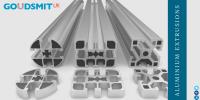 Add My Company
Add My Company
Sign In
Current Trends in Aluminium Extrusions
08-04-2019

The extrusion process of aluminium enables manufacturers to take advantage of the large number of design options it offers. The use of aluminium alloys in the extrusion sector has grown annually by 6 % during the last 5 years.
The extrusion process of aluminium involves heating and forcing the softened metal through an opening in the shape of a die until the profile emerges. The range of shapes that can be produced by extrusion is almost infinite, hence the reason of its popularity. Due to this, there are several general rules that detail potential solutions and appropriate tolerances. Due to the strength, flexibility, durability and sustainability aluminium extrusions offer, they have started to become increasingly popular in end-user sectors, such as:
Construction
Transport
Electricity
Machinery
Consumer goods
Market developments
In 2017, it was estimated that 28 million tons were processed globally. However, the consumption volume remains below the total processing capacity of all the companies combined in the sector, which surpasses 40 million tons per year. Though, recent trends indicate the demand will reach the total of the current capacity in under 5 years. The extrusion industry keeps increasing its productivity and competitiveness. Plants are moving toward modernisation in order to use presses with higher pressure forces, replacing old systems. Due to the evolution within the market, bigger presses are required to produce more resistant and larger parts.
Sectors that are leading the demand
1. Aerospace
Extrusions and aluminium laminates are increasingly being used in the aerospace industry. Mainly since its strength increases at low temperatures, an admirable quality at high altitudes. Anodising the main parts of an aircraft, increases its resistance to corrosion and therefore protecting it from harsh weather conditions. This includes the structures of wings, the fuselage and deflector engines. In addition, aluminium laminates are used military applications. In both combat aircrafts and in commercial aviation, where its use is driven by the mechanical requirements of the new generation of aircrafts, including the Airbus 350 and Boeing 787. The aerospace industry has also been extensively using this metal in the space shuttle program, and NASA have chosen a high strength aluminium and lithium alloy to manufacture the new Orion spacecraft.
2. Automotive
In the automotive industry, weight has a substantial impact on the performance of a car. For electric cars, aluminium allows the construction of light body frames, alongside offering the strength and rigidity required to counteract the weight of the batteries. Also, aluminium alloys streamline the assembly process, providing better energy absorption properties in the event of an accident than any other material. The demand and use of aluminium in cars vary from one country to another for numerous reasons. Nevertheless, the cars of the future must meet strict emission standards. In fact, according to CRU metals consultants, the sales of electric and hybrid vehicles will reach 30 % of the global automotive market by the year 2030.
3. Boats
Boat manufactures in general use aluminium because of its greater resistance compared to fiberglass. Aluminium makes it possible to produce boats with strong and rigid structures. Due to its elasticity, aluminium has a greater capacity to absorb distortions without breaking or cracking on impact. However, if a breakage occurs, it can easily be repaired by being welded, achieving better sealing properties. In addition, due to the weight savings, less propulsion is required to achieve the same performance. Therefore, reducing the strain on the engine, reducing emissions and creating more environmental advantages.
4. Electronics & IT
The electronics and IT sector has also started to use extruded components. During the first half of 2018, Apple alone used more than 4,000 tons of lightweight metal in its aluminium-coated iPhones. The electrical industry uses aluminium in high voltage towers, where the power line should be light, flexible, and as economical as possible. In this area, it also offers a high resistance to corrosion and ease of welding, making electrical installations more durable and easier to repair.
Goudsmit UK
Goudsmit UK produce bespoke extrusions based on your design and volume requirements. The experienced and dedicated team at Goudsmit UK is committed to manufacturing high quality parts that meet your specifications and are delivered on time and within budget. Extruded parts can be manufactured to ISO 9001, AS 9100D and IATF 16949 quality standards.
Contact us today for more information at info@goudsmit.co.uk. Or you can also speak to a member of our team call us on +44 (0) 2890 271 001.
For more information on our extrusions visit our webpage or download our brochure.
Follow us on LinkedIn, Twitter and Facebook for regular updates.
For more information on Current Trends in Aluminium Extrusions talk to Goudsmit Magnetics (UK) Ltd
Enquire Now
List your company on FindTheNeedle.

